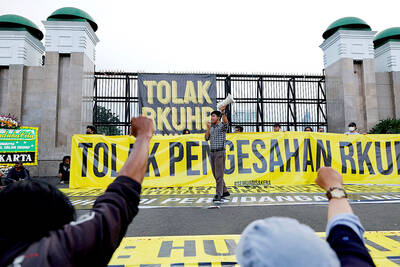At the birthplace of the atomic bomb, outside the national labs that feed today's nuclear arsenal, and in the US' capital, survivors of the deadly blasts that devastated Hiroshima and Nagasaki 60 years ago joined hundreds of activists in support of a global ban on nuclear weapons.
"No more Hiroshimas. No more Nagasakis," bombing survivor Koji Ueda wrote in a statement distributed on Saturday at a rally in the Los Alamos park that had held research laboratories when the Manhattan Project developed the world's first atomic bomb.
"We send this message to our friends all over the world, along with a fresh determination of the `hibakusha' [atomic bomb survivors] to continue to tell about Hiroshima and Nagasaki, aiming at a planet set free of wars of nuclear weapons," Ueda said.
In Oak Ridge, Tennessee, 15 protesters from a group of more than 1,000 were arrested on Saturday for blocking a road outside the heavily guarded weapons factory that helped fuel the bomb during World War II.
At the Nevada Test Site, peace activists discussed ways to eliminate nuclear weapons. While in California, hundreds of activists marched to the gates of Lawrence Livermore National Laboratory, some holding sunflowers and others hoisting a 12m inflatable "missile."
Ueda, who was 3 when the bomb was dropped on Hiroshima, was joined at Los Alamos by Masako Hashida, who was 15 and working in a factory about 1.5km from where the second bomb fell three days later on Nagasaki.
In the Los Alamos park where research laboratories stood during the Manhattan Project, placards carried anti-war slogans including "No more war for oil and empire" and "We're sorry about Hiroshima and Nagasaki."
A group of veterans offered an opposing message across the park from the more than 500 activists. One sign read: "If there hadn't been a Pearl Harbor, there wouldn't have been a Hiroshima."
Steve Stoddard, 80, of Los Alamos, said the group was trying to counter the "demonizing of the bomb."
"We feel the bomb saved our lives," said Stoddard, a World War II veteran who fought in Europe. He believes he would have been sent to fight in Japan had the bombs not ended the war when they did.

Indonesia yesterday began enforcing its newly ratified penal code, replacing a Dutch-era criminal law that had governed the country for more than 80 years and marking a major shift in its legal landscape. Since proclaiming independence in 1945, the Southeast Asian country had continued to operate under a colonial framework widely criticized as outdated and misaligned with Indonesia’s social values. Efforts to revise the code stalled for decades as lawmakers debated how to balance human rights, religious norms and local traditions in the world’s most populous Muslim-majority nation. The 345-page Indonesian Penal Code, known as the KUHP, was passed in 2022. It

‘DISRESPECTFUL’: Katie Miller, the wife of Trump’s most influential adviser, drew ire by posting an image of Greenland in the colors of the US flag, captioning it ‘SOON’ US President Donald Trump on Sunday doubled down on his claim that Greenland should become part of the US, despite calls by the Danish prime minister to stop “threatening” the territory. Washington’s military intervention in Venezuela has reignited fears for Greenland, which Trump has repeatedly said he wants to annex, given its strategic location in the arctic. While aboard Air Force One en route to Washington, Trump reiterated the goal. “We need Greenland from the standpoint of national security, and Denmark is not going to be able to do it,” he said in response to a reporter’s question. “We’ll worry about Greenland in

PERILOUS JOURNEY: Over just a matter of days last month, about 1,600 Afghans who were at risk of perishing due to the cold weather were rescued in the mountains Habibullah set off from his home in western Afghanistan determined to find work in Iran, only for the 15-year-old to freeze to death while walking across the mountainous frontier. “He was forced to go, to bring food for the family,” his mother, Mah Jan, said at her mud home in Ghunjan village. “We have no food to eat, we have no clothes to wear. The house in which I live has no electricity, no water. I have no proper window, nothing to burn for heating,” she added, clutching a photograph of her son. Habibullah was one of at least 18 migrants who died

Russia early yesterday bombarded Ukraine, killing two people in the Kyiv region, authorities said on the eve of a diplomatic summit in France. A nationwide siren was issued just after midnight, while Ukraine’s military said air defenses were operating in several places. In the capital, a private medical facility caught fire as a result of the Russian strikes, killing one person and wounding three others, the State Emergency Service of Kyiv said. It released images of rescuers removing people on stretchers from a gutted building. Another pre-dawn attack on the neighboring city of Fastiv killed one man in his 70s, Kyiv Governor Mykola